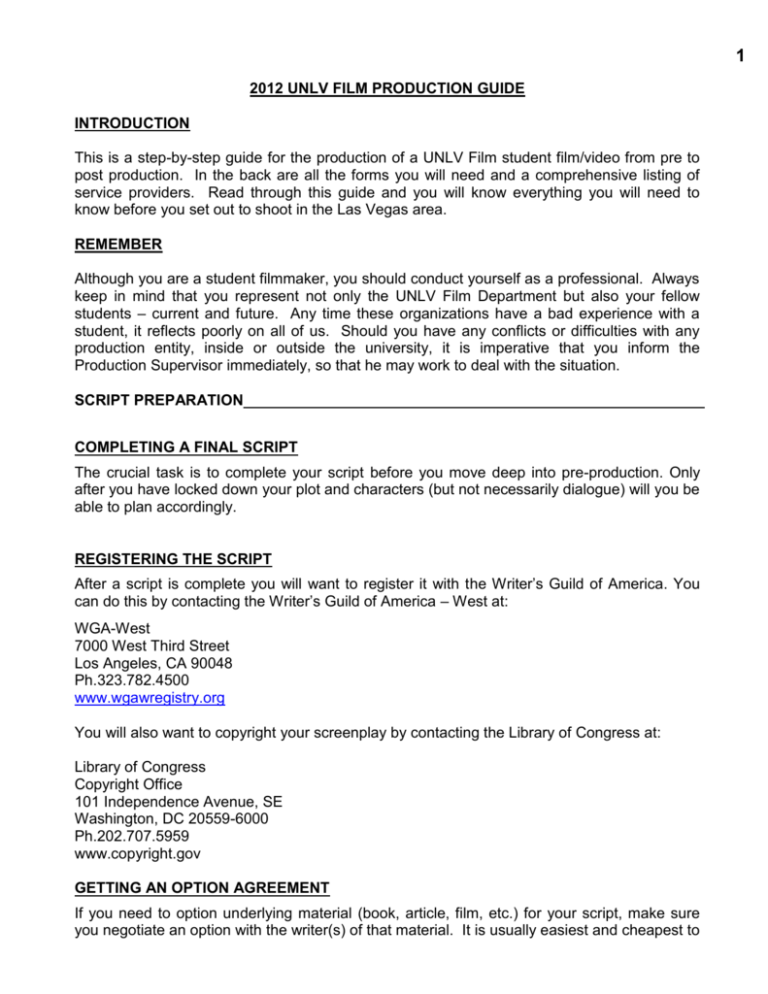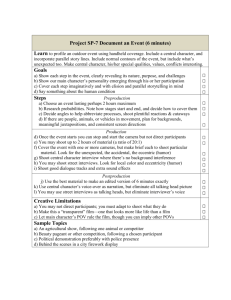2012 UNLV Film Production Guide - University of Nevada, Las Vegas
advertisement

1 2012 UNLV FILM PRODUCTION GUIDE INTRODUCTION This is a step-by-step guide for the production of a UNLV Film student film/video from pre to post production. In the back are all the forms you will need and a comprehensive listing of service providers. Read through this guide and you will know everything you will need to know before you set out to shoot in the Las Vegas area. REMEMBER Although you are a student filmmaker, you should conduct yourself as a professional. Always keep in mind that you represent not only the UNLV Film Department but also your fellow students – current and future. Any time these organizations have a bad experience with a student, it reflects poorly on all of us. Should you have any conflicts or difficulties with any production entity, inside or outside the university, it is imperative that you inform the Production Supervisor immediately, so that he may work to deal with the situation. SCRIPT PREPARATION COMPLETING A FINAL SCRIPT The crucial task is to complete your script before you move deep into pre-production. Only after you have locked down your plot and characters (but not necessarily dialogue) will you be able to plan accordingly. REGISTERING THE SCRIPT After a script is complete you will want to register it with the Writer’s Guild of America. You can do this by contacting the Writer’s Guild of America – West at: WGA-West 7000 West Third Street Los Angeles, CA 90048 Ph.323.782.4500 www.wgawregistry.org You will also want to copyright your screenplay by contacting the Library of Congress at: Library of Congress Copyright Office 101 Independence Avenue, SE Washington, DC 20559-6000 Ph.202.707.5959 www.copyright.gov GETTING AN OPTION AGREEMENT If you need to option underlying material (book, article, film, etc.) for your script, make sure you negotiate an option with the writer(s) of that material. It is usually easiest and cheapest to 2 contact the writer directly for the rights to use their material. You will (in most cases) be asking for rights to create a short film out of the material so you will not have much or any money for the rights. By avoiding the manager or agent, you can often get an easier “yes” and a more affordable deal for the rights if you can deal with the writer solely. If you cannot get to the writer directly or if they ask you to negotiate with their agent, then contact that person and ask for the short film rights. You can find an example of an option agreement that you can customize however you’d like for your particular needs at the back of guide. Often the literary agent will have their own document or deal memo for you to sign. If that is the case, make sure you contact a lawyer before signing anything. ASSEMBLING A SHOOTING SCRIPT After you've completed your script, you can now put together the scenes that will be shot in one location, and reassemble the script so that scenes are grouped according to location. This is the version of the script that should be copied for key crew members. DOING A SCRIPT BREAKDOWN The script breakdown takes the script apart and allows you to determine exactly what you’ll need for each and every scene: cast, extras, props, vehicles, wardrobe and makeup, special effects, stunts, sound effects and special equipment. If you have a large enough crew, each department head (Set Designer/Art Director, Wardrobe, etc.) may do their own. Only by doing your own breakdown will you be sure that you haven’t forgotten anything. You can create your own breakdown sheet, or use the one at the back of this guide. DRAWING UP A SHOT LIST The director is responsible for drawing up a list of shots, from master shots to extreme closeups, to assure that you get the coverage you need. Do this first by taking your script and outlining (in vertical lines along the side) what types of camera positions you want to cover each piece of dialogue and action. At this stage, seek the advice of your director of photography, if you have already selected one. Depending on how you wish to shoot your project, it can be helpful to cover each scene in a master shot, as well as covering important action from more than one angle. Plan your shots to give yourself options in the editing room, and plan to shoot cutaways and reaction shots—you will invariably need them. Shooting a crucial scene from only one angle, with no cutaways, can become problematic in the editing room. CREATING FLOOR PLANS / STORYBOARDS Even before you’ve settled on locations, you should have a strong idea of what type of space you envision for each scene. Creating floor plans will help you define this. On your plans, include room/exterior layouts, character movement, camera placement and angles. Create storyboards as well. These allow you to pre-edit your video on paper. They do not have to be works of art; they must merely depict exactly what the camera will see each time the shot changes. For those who are drawing challenged, you have three other options: once you’ve decided on locations, 1) create photo storyboards by snapping photographs of each planned shot at each location; or 2) take a video camera and have a few friends walk through your 3 script so that you can create a video storyboard or just draw stick figures - as long as the director and DP understand the shots that is all that matters. BUDGETING CREATING AN ESTIMATED BUDGET When you're working on very short video projects, it's easy to imagine that you can get by without spending a cent. Wrong! You'll have at least the cost of camera supplies, food and transportation, even if you spend nothing on props, costumes and locations. There are ways to cut corners, of course, but it is worth repeating that you should never skimp on food. Your cast and crew will do better work if they’re well fed and it’s the humane thing to do. You must do a preliminary breakdown so that you can tell your art department people how much they can spend. After you have finished shooting and the post production on your project you need to actualize your budget. And if you are using SAG actors, you will need to supply a final, detailed budget to SAG when you’ve finished editing your film/video. You will find a sample budget at the end of this guide. CASH FLOW AND PRODUCER/DIRECTOR AGREEMENTS A necessary part of prepping for your film/video requires you to decide on how much money will be used for the project, where that funding is coming from and how the project will be cash flowed. In most projects at UNLV the funding comes from the Director but is spent and allocated by the Producer. It is very important to work out weeks ahead of time how much will be spent (through the estimated budget that is created by the Producer and approved by the Director). It is also vital that a cash flow schedule is established so the Producer has the necessary monies in hand during pre-production, production and post-production. This prevents the production from coming to a grinding halt when the money is not there to pay for catering, equipment rentals, film stock, etc. In addition, the Producer should never pay out of their own pocket for petty cash or credit cards. Better to have the proper amount of money on hand during production so there are not problems after wrap. There should be an understanding as to howquickly the Producer will actualize the budget so the Director has a full accounting of monies spent with the actual receipts for each line item. CREWING SELECTING YOUR CREW Your crew will probably consist of many of your fellow UNLV Film students, so select wisely and be prepared to return the favor when it comes time for their own shoots. The size of your crew depends on the size and length of your shoot, but you should at least have the following: Producer, Director of Photography, Produciton Manager, Assistant Director, Assistant Camera, Sound Recordist, Grips, Production Assistants. 4 It’s best that each of these positions is held by the same person for the duration of the shoot; this greatly increases your chances that the shoot will be efficient and free of continuity problems. Of the above positions, keep in mid the importance of the AD and make sure you find a good person for that position. There are other positions you may want to consider - Production Designer or Art Director, Props, Wardrobe, Hair/Makeup, Script Supervisor, Boom Operator, Editor and Craft Service person. But remember that every person is another body to transport and feed. And on small sets, large crews quickly get cramped. Many students have found great crews through the UNLV Film Facebook page, the Nevada Film Group Facebook page, the Nevada Film Office, www.mandy.com, www.productionhub.com, and www.craigslist.com. You can post requests for crew and interested people email you back for your project. Once the script is finalized, the producer or production manager can do a script breakdown and begin creating the production schedule. The schedule will be informed by many factors—locations, weather, time of day, budget, etc. Therefore location scouting should begin as soon as possible. The DP is responsible for capturing the director’s vision on film or tape. The DP lights, frames and shoots the video, a position whose importance cannot be understated. Before you decide on a DP, solicit sample reels from your candidates, watch them with your producer, and talk with your short-listed choices before making your decision. Make sure they have seen a copy of the script and agree they are capable of shooting the style you’re after. Don’t compromise on choosing a DP and also make sure they are easy to work with and do not have too much "attitude". No matter how talented someone is, having an attitude can be extremely debilitating to a student production where everyone on the crew has to compromise. The DP must be able to work well with the gaffer you select (confer with the DP first) or whoever the DP brings to the production, and he/she is responsible for the other technical crew. The gaffer determines lighting requirements and assures that all technical aspects of the shoot go smoothly. Grips manipulate the equipment stands, light-diffusing materials and other (non-electrical) movable objects on the set. Electricians deal with electrical power, cables and setting up all the lights. PAs should be on hand to fulfill any and all tasks they are assigned, including craft service and meals. FINALIZING CREW There may be last-minute changes in crew availability; this can frequently be avoided by making sure your crew feels involved in the project and invested in its success. Give your crew as much information as possible, as early as possible. Plan to have a meeting with your key crew a week before you shoot, and give them the shooting script, shooting schedule, locations, call times and contact lists. FILING INSURANCE FORMS See Insurance Section. 5 CASTING DEVELOPING CHARACTER DESCRIPTIONS Before you begin the process of casting your project, make sure you know exactly what you’re looking for. Try developing at least a paragraph on each main character, delineating age, gender, socioeconomic background, employment and interests. The more you can fully develop your script’s backstory and flesh out your characters, the better chance you’ll have casting the right actors. CASTING You can place a casting ad on the following sites: www.craigslist.com www.backstage.com www.breakdownservices.com HOLDING AUDITIONS/CALLBACKS Try to gang up auditions with a few other students, since this will allow you each to see more actors and to share perspectives on performance. Once you’ve reserved audition space, begin calling the actors you’d like to see and assign them a specific time to appear (open calls are usually chaotic and ineffectual). Be sure you get their home phone numbers and cel numbers; résumés often provide only an agency number. Be prepared to give a very brief synopsis of the plot to each of them, along with fuller descriptions of the character you want them to audition for. You can email actors the “sides” (short scene from your script that you’d like them to perform in the audition). Be sure to remind them to bring in extra headshots/résumés when they come. If you want to videotape the auditions, low-end video packages are available from the Equipment Room. Make sure you do the following: Arrive early, with fellow students along to help set up the room, sign in the actors, and be readers for you. Provide seats in the hallway for those waiting. Have stapled “sides” ready for actors when they arrive; allow them a few minutes to read through them. Hand out Personal Information sheets to fill out while they wait; it will answer all your questions about their availability. Always thank the actors for coming, and tell them that you will call them by a certain day if they have been chosen. Remove all trash, return room/hall to original configuration, and take down your signs. 6 FINALIZING CASTING/FILING WITH SAG Once you’ve made your decisions, and you’re sure that the actors you’ve chosen will be available both for rehearsals and for the duration of the shoot, give them a call. If the actors are non-union, be sure to obtain a signed release form from them. There is a sample form at the back of the Guide. Please note that SAG actors cannot and do not sign a release form, they are covered under the SAG rules which you agree to when you sign the SAG Student agreement. In addition, be aware that NV State law requires that any child under the age of 16 years must have a special permit to work on a shoot issued by the Office of Special Services for Children. You and the parent or legal guardian are responsible for obtaining this permit. You will need at least a week to gather all the info and make the application. If any of your actors are members of a union (AFTRA, Equity, Screen Actors Guild), you must fill out and mail in a Screen Actors Guild Agreement . This protects your actors (and you!) by providing health insurance and assuring them of salaries if your film/video is picked up for distribution and brings in more money than you spent making it. REHEARSAL BOOKING REHEARSAL SPACE If possible, rehearse your actors in the locations where you plan to shoot. If you cannot, mark the dimensions of your location with tape on the floor of your rehearsal space. Rehearse early: your actors will inspire you to change some of the decisions you’ve made about how certain scenes should be shot, and you will be forced to really refine your vision, since you will have to explain it to your actors. If you want to videotape rehearsals, low-end video packages are available from the Equipment Room. HOLDING REHEARSALS Follow essentially the same steps for rehearsing that you followed for auditioning—except that you won’t need other students to assist. Remember: you should not plan to rehearse more than 2-3 hours each time, and you should provide drinks and munchies. LOCATIONS SCOUTING LOCATIONS No matter where you film, you will be required to fill out paperwork—whether to obtain insurance or to receive shooting permission—so read the following sections carefully. Realize that you often have to pay for the use of some locations, even if it is just for electricity and/or security. Put a line item in your budget for location fees to cover yourself. 7 Be advised that you may have problems getting permission to shoot in hospitals - due to space shortages, the cost of providing security during the shoot and obvious problems with patients. FINALIZING LOCATIONS/TECH SCOUT Make sure your DP is on hand during the final stages of scouting, to assure that it is reasonable to shoot at the locations you’ve selected, considering size, lighting, and electricity requirements. Scout your location on the same day of the week and at the same time of the day you plan to shoot. (i.e. If you plan to shoot on Monday night, visit the location on a Monday night). Also, be aware of any situations or events that may conflict with your shooting schedule. Try to make sure there will not be any construction work going on the day of your shoot if you will be recording audio. Also national holidays my impact your shoot, so check ahead of time. Wherever you shoot, make sure your entire cast and crew conduct themselves like professionals. Return all locations to a state better than when you arrived; and leave behind nothing but a good impression. Trash must be removed from the location each day at wrap, and you are not allowed to use Department of Sanitation trash cans to do this. Find out ahead of time where they want to you dispose of the trash. Prior to shooting make sure you go around the location with the owner and take pictures of the area and write down anything that is already in a damaged condition prior to you shooting. Then have the owner sign the sheet and agree to it. After you have wrapped out of the location do this again with photos and have the owner sign a piece of paper stating that the location is in good condition and there as been no damage from your crew. This is important to do – unfortunately there have been a few owners in the past that have tried to intimidate students into paying for repainting or repairs to their location that were not caused by the student’s production. Be careful to document the location properly. You have numerous options for interior location shooting; the easiest might be to shoot in your own or a friend’s apartment. If the location is privately owned, you should obtain written permission from the owner of the property—not just the tenant—to avoid getting thrown out in the middle of your shoot. In the back of the guide is a template for a location release form that can be used. Make sure the owner of the property signs the form before you begin filming (get it signed days ahead of time) so there are no problems or misunderstandings on the day of the shoot. For productions that will be shooting in a Co-op or Condo apartment, you need to contact the Co-op or Condo Board that controls the apartment building and get their written approval as well. These boards usually meet once a month so you need to get in touch with them at least 6 weeks ahead of time so you can get your request on the schedule for their next meeting prior to you shoot. If you do not have their approval you could be shut down on your shoot day even if you have the owner’s written consent. 8 FILING INSURANCE FORMS You must file a location insurance form for every single location in which you plan to shoot. See Insurance section. GETTING PERMITS A permit from the Nevada Film Office is required for shooting in any public space, including all streets, parks, beaches, or public buildings. BEING PREPARED ON SET Two days before you plan to shoot you should have a production meeting at which all key crew members are present. A production meeting will allow all members to communicate with one another and discover problems before you get to set. Each person should have a copy of the script, shooting schedule, list of locations, and for the gaffer and DP, a shot list. Go through each of these documents with your crew. You may be surprised at how much information you will learn (i.e. you may schedule 5 hours at a location but upon looking at your shot list and discussing the location, your gaffer disagrees with the time allotment.) It is better to discover these problems and issues in advance, even though there will be times when you just have to get on set and make it work. PROPS AND COSTUMES DRAWING UP WANTED/NEED LISTS If you aren’t able to find just the right look for your set, you may have to create it yourself. This is where it behooves you to have an art director or a set designer; just make sure that you explain precisely what you envision, show them your Script Breakdown sheet, and agree in advance on the budget for achieving it. Costumes can be very expensive, especially if you’re renting them. You’re frequently better off making your own, since there are plenty of cheap fabric stores. Police uniforms must be rented, and you’ll need to have all the required paperwork confirming that you're using them only in a film/video. If you will have exterior shots with actors in police uniform, you must get a permit from the Nevada Film Office. Discuss wardrobe needs first with your producer and DP; then ask your actors if they have something suitable. They frequently will. Make sure you draw up lists early on. The sooner you nail down all your necessary purchases, the sooner you can get on to more important matters. 9 EQUIPMENT DRAWING UP WANT/NEED LISTS Get together with your DP and decide what equipment you will need for your shoot. You will receive a basic video or film camera package from the Equipment Room; if they are available, you may also check out such equipment as flags, portable monitors or dollies. If you have special needs (lenses, Steadicam, etc.), and your DP doesn’t have access to such equipment, consult the services listings in the back of this guide (see Equipment—Rentals). Decide what you're going to rent well in advance of the shoot, so that you have time to insure it properly. It’s important to work with the DP to accommodate their technical needs but it is also important to keep within your budget limitations. Some Dps may have unrealistic expectations of what you can afford. Do not be intimidated into obtaining equipment that may not really be necessary. If this becomes a problem you need to discuss it honestly with the DP and either scale back your production ambitions or find a different DP that may be able to work with less equipment. RENTAL HOUSES When insuring rental house equipment, refer to INSURANCE SECTION for all guidelines and procedures. At the time of pick-up, be sure to bring all of your insurance documents with you in order to avoid any last minute confusion. During pick-up check that each piece of equipment you are given is the right piece and it works properly. If you take the equipment away and do not check it first and it is broken or does not work properly, you will be responsible for paying for its repair or replacement! Make sure you check all the equipment ahead of time. Also, be sure to allocate enough time so that the rental house personnel can instruct you on the proper use of the equipment. Lastly, be aware that some rental houses will expect payment in cash or for you to put a deposit on a credit card until the equipment is returned in good condition. Call ahead and find out their policy. CHECKING IN LOSS, DAMAGE, THEFT AT THE EQUIPMENT ROOM/ If you return equipment late, you will be fined. If your tardiness prevents another student from shooting, you will be liable for reimbursements of any related rental charges incurred by that student. INSURANCE OVERVIEW Insurance is a very important aspect of producing a film/video. You need it to cover your liability for location shooting, for equipment rental, and for worker’s compensation for your cast and crew. UNLV does not provide insurance for your film shoots. You must secure it on your own. Here are some companies where you can purchase insurance from: 10 http://www.entproins.com http://www.filmemporium.com http://www.venturainsurance.com GENERAL LIABILITY/LOCATION INSURANCE General Liability insurance is used to cover liability when you are shooting on a location. General Liability insurance covers bodily injury and property damage to a third party. EQUIPMENT RENTAL INSURANCE Equipment Rental insurance covers any damage or loss to equipment that is rented or borrowed from a Rental House or Third Party. You will need to apply for a separate certificate for each Rental House/Third Party that you are renting equipment from. WORKER’S COMPENSATION Worker’s Compensation insurance covers claims/medical expenses when someone is injured on your shoot. RELEASE FORMS You will need to use two different kinds of release forms for your productions - Talent release forms and Location Release forms. These are critical because they allow you to have legal permission to use and photograph/videotape your actors and also to be and use a location that you have selected. 11 Copy the Talent Release form and have every non-SAG actor sign it prior to you shooting them in your production. Copy the Location Release form and have the Owner of the location(s) you wish to shoot in sign it several days prior to your shoot. You need to have the owner of the location sign it for it to be legal. If it is a Condo or Co-op you may also need to get permission from the Condo/Co-op Board, so plan accordingly. If there will be a fee charged for the location, write that on the location release form as well. Get everything signed and in writing before you begin your production! Please note that the Release forms are for reference only and are not in lieu of professional legal counsel. You can amend them to reflect your usuage and UNLV is held harmless for any liability if you choose to use them. There is also an example of a Producer/Director agreement at the back of the Guide. You can amend it however you like. The Producer and Director should sit down at the beginning of the project and decide on duties, credit and how money will be handled. You should then write it all down and sign it before you start the production. It will save you a lot of headaches later on and make things clearer between the two of you. FILMING PERMITS Permitting in Nevada is multijurisdictional across city and county lines. The completion of a Film Permit Application is required to film in the State of Nevada. An application package must be submitted to each desired filming jurisdiction. The application package typically consists of a Film Permit Application and Film Location Permit which outlines any special production needs such as pyrotechnics, traffic closures, etc. Turn-around times for the receipt of a permit vary, and depend on the specifics of the production’s requirements. In Nevada, as in most places throughout the United States, proof of liability insurance by a company licensed to provide insurance in the State of Nevada is required in addition to a film permit. There are separate permitting requirements for locations outside of city and county limits such as: The Fremont Street Experience in Downtown Las Vegas, Bureau of Land Management (BLM) areas, National parks and State roads and highways. Many Nevada county and city permits are free. Fees for wilderness and recreation areas, state parks and similar locations are based on the size of the crew, number of vehicles, type of use intended, expected impact and other variables. For additional details on fee requirements, please contact the counties and/or cities directly. FILMING ON THE "STRIP" Many sidewalks on Las Vegas Boulevard or “The Strip” are the private property of the hotels they border. In most cases you may have to contact the hotels directly to obtain permission to film on the sidewalks in front of their properties. Las Vegas Boulevard falls within the jurisdiction of Clark County and the City of Las Vegas. The dividing line is Sahara Avenue. Las Vegas Boulevard North of Sahara is the City of Las Vegas and South of Sahara is Clark County. For more information on film permits call the Nevada Film Office toll free at 877-NEV-FILM (877-638-3456) and at 702-486-2711 or visit nevadafilm.com. 12 SCREEN ACTOR’S GUILD SAG You must fill out a SAG agreement if you are using SAG/union actors on your film or video or you plan to use a breakdown service and/or other professional casting method (ads) to find actors. The reason for this is that most casting services will require that your film be a SAG waiver film- whether you use SAG actors or not is up to you. If you are filing because you are using SAG/union actors then you must fill out the agreement and return it to SAG no later than two weeks prior to filming. When you return the SAG agreement, you will be given a Student Film Handbook, Actor’s Contract form, Final Cast List form, and a Production Time Report form. Make copies of the forms and read the handbook on how each form should be filled out. The forms will need to be filled out during production. After you have completed production, you will need to return the Actor’s Contract form (one form per SAG actor), Final Cast List form (one form), and Production Time Report (one form for each shoot day) to SAG. It is important to send in all of your paperwork to SAG after you have wrapped production. If you do not “close out” your file, SAG can refuse to allow you to use SAG actors for your next production. Don’t give SAG a reason to dislike you! Return these forms within 1 month of the day your wrapped your production to: Screen Actor’s Guild Nevada 3960 Howard Hughes Parkway Las Vegas, NV 89169-5972 (702) 737-8818 CHILD PERFORMER PERMIT You can check out the requirements for your state here: www.onlocationeducation.com CATERING / CRAFT SERVICES SELECTING FOOD PROVISIONS Food will be one of the largest expenses on your shoot no matter how you procure it. You can expect to pay at least $6 - $8 per person per meal, once you’ve tallied up all the supplies. Some students make deals with restaurants/delis in the area or near your locations, and some make deals with fellow students to provide home cooking. But if your locations do not have a refrigerator or stove, you have fewer options. It can not be stressed enough how important it is to feed your crew and actors well. People who are working for free work better and more enthusiastically when they are well fed. Never skip meals. You must feed your cast and crew a meal every six hours. This is the industry standard and needs to be followed for all productions. It is a safety issue and a humane issue. Whether or not you have SAG actors on your set, it is important to follow the SAG rules regarding meals: 13 Actors must be broken for meals within 6 hours of the first call time. Subsequent meal breaks must be called within 6 hours of the end of the previous meal period. Each meal must be at least 30 minutes but no longer than one hour. Breakfast typically consists of coffee, juice, bagels, cream cheese and fruit. Lunch should be something substantial: a hot meal, hearty sandwiches and salads. If you’re shooting at night, you’ll be more popular if you provide a warm meal. You can order pizza just so many times before a mutiny will occur. Variety is the spice of creative endeavor. Also remember to check to see how many vegetarians you have on your crew and get the appropriate food for them. Check the listings in the back of this guide for suggestions. Your craft services person should plan to do the following: Provide things to nibble on (veggies, cheese and crackers, fruit, chips/pretzels). Make sure you have vegetarian selections. Avoid serving sweets until close to wrap so that your crew doesn't suffer sugar highs and lows. Have coffee and tea on hand if possible. Provide plenty of drinks without caffeine, especially during the summer. Have a collection of menus on set—pick these up in advance from likely spots in the neighborhood of your shoot. A big jug of water and cups are essential! If your location does not have kitchen amenities, plan on having a cooler for ice, milk and drinks. TRANSPORTATION RENTING VEHICLES You will find a comprehensive listing of rental car companies in the back of this guide. Check with them about their best rates—and don’t forget to mention that you’re a student. The nationwide companies all provide discounts—and may be safer than the ultra-cheap renters. If you are renting a vehicle, be sure you cover the days of equipment pick-up/dropoff. Also be sure to take out insurance with the rental company for all your drivers, even though it may cost a few dollars more. Don’t be cheap about this—be safe. This includes vehicles with an engine used during film production, as well as picture vehicles, camera and grip/lighting. PRODUCTION FINALIZING SHOOTING SCHEDULE You should finalize your shooting schedule as early as possible, to enable the smooth—and timely—processing of insurance forms and permits. You should plan the whole shoot as you think it can feasibly be shot. Here are some hints: 14 If possible, don’t shoot your most difficult scene on the first day. Plan exteriors early in the shoot, in case you have to accommodate foul weather and need to change to interior locations. Don't change locations frequently in one day, unless they are exteriors and near each together. Plan realistically for loading in, set dressing, lighting setups, dolly rigging, wardrobe changes, meals, limited daylight, company moves and loading out. Give your cast/crew a 10-12 hour turnaround. Don't delude yourself into thinking that everything is going to fall into place once shooting starts. It usually tends to fall apart. Once you’ve finalized your schedule use the production packet template that you received during your Producing the Short class to put all the vital production info in a clear, concise way so every department has the information they need for the shoot. Also make sure you have signed the Producer/Director Agreement, Location and Appearance release forms and deal memos with your crew. SET ETIQUETTE The key to staying calm and focused on set is taking the time during pre-production to be prepared and communicate your needs with your cast and crew. General rules during the shoot are: Actors must be broken for meals within 6 hours of the first call time and every six hours after that. Meals should be at least 30 minutes but not longer than one hour. Remember that everyone is at least twice as tired as you are—you’re pumped with adrenaline and they are not. Before you load the equipment out of every location, check each piece against the photocopy of your checkout list. Allow at least 10-12 hour turnaround between shooting days. (From the call time of Wrap until the first Call time of the next consecutive shooting day) Thank everyone profusely at the end of each day; they're doing you a big favor, and they want to feel appreciated. Revise the schedule at the end of each day to account for whatever shots you've missed or added. Hand out sheets with call times, location information and directions at the end of each day for the next shooting day. During the shoot your producer must fill in and get signed SAG Contracts, Final Cast List and Production Time Reports for each professional actor. You must keep a record of each professional performer’s travel time. At the end of each day of filming, each professional actor (including those in Equity, AFTRA and other professional unions) must sign the Production Time Report in ink next to his/her name to verify the hours. These forms are part 15 of the paperwork you must submit to SAG at the end of production (see Wrapping Principal Photography—Filing SAG Forms). WRAPPING PRINCIPAL PHOTOGRAPHY THANKING CAST AND CREW Within days of wrapping your shoot, you should send notes to each and every cast/crew member. That’s a simple goodwill gesture that will be much appreciated. It is also advisable that you send thank you notes to anyone who went out of their way to help your shoot run smoothly. You should always provide a DVD of the finished video to each and every actor. This is true whether or not you used SAG actors (who must receive a DVD as per the agreement you signed). FILING SAG FORMS Within 1 month of the completion of your shoot, you must send the required forms to SAG: Actors' Contracts A Final Cast List Production Time Sheets (see Production—On Set) A final actualized budget Your actualized budget should be determined by going through your receipts and finalizing expenditures. Consult your SAG Student Film Handbook if you have any questions. Compile all SAG paperwork and mail it to: Screen Actors Guild POST PRODUCTION ISSUES MUSIC CLEARANCE You have two choices for the music for your project. You can hire a music composer or you can acquire the music rights to existing songs/music. If you hire a composer you will need to get them to sign a music release form giving you the rights to use the music in your project on an exclusive or non-exclusive basis. Be sure to state if you are acquiring the rights for all usage/distribution outlets and for all media worldwide in perpetuity. This process usually takes several months so start as soon as you know what music you want to acquire for your project. If you are acquiring the rights of an existing piece of music you need to purchase two kinds of rights – the Synchronization (Sync) License and the Master Recording License. A Sync License pertains to the song itself and is written authorization to synchronize that song with visual images such as movies, TV, videos, websites and so on. Sync Rights are usually, though not always, controlled by the music publisher. A Master Recording License pertains 16 to the recording of a performance. Master Use Rights are usually, but not always, controlled by the record label. You will need to contact the publisher and the record label for each piece of music through the Licensing Dept. They will ask you to send an email or fax with the name of the song, the album, composer, scene description (in your project), the running time for the portion of the song you are using in the film/video, license request for rights (all, film festival only or online,etc.), license request length (i.e. in perpetuity) and your fee offer (how much you can offer to pay). Then you will begin negotiating for price and usage with the Licensor. It’s always best to ask for all rights but you may need to limit the amount of rights you can afford and ultimately decide to just purchase film festival and/or web rights. Copyright ownership is for 75 years, after which the rights revert to the Public Domain (i.e. free). Regardless of this fact you still need to research any music recording that you think may be in the Public Domain. To do a copyright search, begin with the US Copyright Office online at www.loc.gov.copyright or at the Library of Congress, James Madison Memorial Building, 101 Independence Avenue, SE, Washington, DC 20559. For information on searching records from 1790 – 1978, see “How to Investigate Status of a Work” (Circular 22) located at www.loc.gov/copyright/circs/circ22.html and “The Copyright Card Catalog and the Online Files of the Copyright Office” (Circular 23) at http://lcweb.loc.gov/copyright/circs/circ23.pdf. Remember that the song may be public domain but the performance may be still under copyright and you would then need to obtain the Sync License. (thanks to Denise Ohio, The Independent, July 2000 for this music clearance info.) FILM FESTIVAL INFORMATION There are a plethora of film festivals, both domestic and foreign, to which you can send your film/video when it is completed. It is important to get your film seen at festivals so you can make contacts, compete for prizes and even potential less the rights to the film. A site to get information on upcoming film festivals and their application deadlines is at www.withoutabox.com. The website allows you to set up an account and send your applications electronically to the various film festivals. Do your research and find out what is the best festivals for your film. They usually have application fees of at least $25 so it can get expensive very fast. 17 TALENT / MODEL RELEASE Authorization to Reproduce Physical Likeness For good and valuable consideration, the receipt of which from (producer) is acknowledged, I hereby expressly grant to said production company and to its employees, agents, and assigns, the right to photograph me and use my picture, silhouette, biography and other facsimiles of my physical likeness (as they may appear in any still camera photograph and/or motion picture film or videotape, in and in connection with the exhibition, theatrically, on television or otherwise, of any motion pictures or videotape in which the same may be used or incorporated, and also in the advertising, exploiting and/or publicizing of any such motion picture or videotape, in perpetuity, throughout the world, but not limited to television or theatrical motion pictures and may be released in any other future media. I further five the said company the right to reproduce in any manner whatsoever any recordation made by said company of my voice and all instrumental, musical, or other sound effects produced by me. I hereby waive any claim for further compensation in connection therewith except as described in this document. Further, I waive any right to inspect the finished work or approve the use to which it may be applied. I hereby certify and represent that I have read the foregoing and fully understand the meaning and effect thereof and, intending to be legally bound, I have set my hand this Day of , 20____. NAME ADDRESS CITY / STATE / ZIP CODE TELEPHONE SOCIAL SECURITY # 18 LOCATION AGREEMENT The following will serve to confirm the agreement between (“Company”) and you as follows: 1. You hereby grant to Company, its producers, artists, employees and directors the privilege to enter and use the premises known as ______________________________, and located at __________________________________, (“Premises”) for the purpose of producing a videotape or film (“Shooting”) on the following dates:___________________. 2. Company shall maintain in full force and effect, at its own expense, during the period of this agreement, a comprehensive policy of liability insurance. Said policy shall insure and protect Company and you against any and all claims, liability or litigation arising out of or directly connected with the Shooting on the Premises. Company shall have in effect coverage for Company employees against workers compensation claims, as required by law, in the statutory amount. 3. This agreement is subject to immediate termination by you or Company in the event of riots, strikes, acts of God, or any other legitimate conditions outside your or Company's control rendering use of the Premises dangerous or impossible. If possible, should the above termination be required, the production of the Shooting may be rescheduled under the same terms and conditions as stated herein. In no event shall (a) you be liable for any damages to Company for such cancellation; or (b) Company be liable for any damages to you for such cancellation. Company and its licensees shall have the perpetual right to use all footage of the Premises for any purpose and in any media. The undersigned represent and warrant that they have full authority to execute this agreement. AGREED TO AND ACCEPTED: ¨ (Print) (Print) 19 ALPHABETICAL LISTING OF PRODUCTION SERVICES Be sure that you always ask about student discounts—these are usually offered—and stress that you have a minuscule budget. Always call first, since some providers require appointments or specific paperwork in advance. These are just a sampling, check out the following website for more listings: www.nevadafilm.com Here is a site that provides free film contracts: http://filmmakeriq.com/2009/04/588-free-filmcontracts-and-forms/ CASTING www.craigslist.com www.backstage.com www.breakdownservices.com CRAFT SERVICE A VIAGGI BISTRO STUDIO CATERING Email: ViaggiBistro@yahoo.com Website: http://www.viaggibistro.com Phone: 702-326-2209 EQUIPMENT RENTALS A PRECISION VIDEO SERVICE Address: 8275 S. Eastern Ave., Ste. 200, Las Vegas, NV 89123 Email: info@pvsrents.com Website: http://www.pvsrents.com Phone: 702-798-4022 INSURANCE ENTERTAINMENT PRO INSURANCE Address: 9645 Padre Peak Ct., Las Vegas, NV 89178 Email: sharon@entproins.com Website: http://www.entproins.com Phone: 702-639-3997 Cell: 805-338-5983 Fax: 702-639-3994 PROPS A TAD WESTERN PRODUCTION COMPANY Phone: 702-387-7256 Cell: 661-609-2033 Email: atadwest@aol.com Website: http://www.atadwest.com 20 MUSIC—RIGHTS ASCAP www.ascap.com BMI www.bmi.com PERMITS Nevada Film Office Las Vegas Office 555 E. Washington Ave, Suite 5400 Las Vegas, NV 89101 702-486-2711 info@nevadafilm.com SCREEN ACTOR’S GUILD 5757 Wilshire Blvd., 7th Floor Los Angeles, CA 90036-3600 (323) 954-1600 www.sag.org Screen Actor’s Guild Nevada 3960 Howard Hughes Parkway Las Vegas, NV 89169-5972 (702) 737-8818 TRANSPORTATION Twenty Four Seven Production Services Address: 2965 Westwood Drive, Las Vegas, NV 89109 Email: Gil@247productionservices.com Website: http://www.247productionservices.com Phone: 702-699-7053 Cell: 702-376-8648







